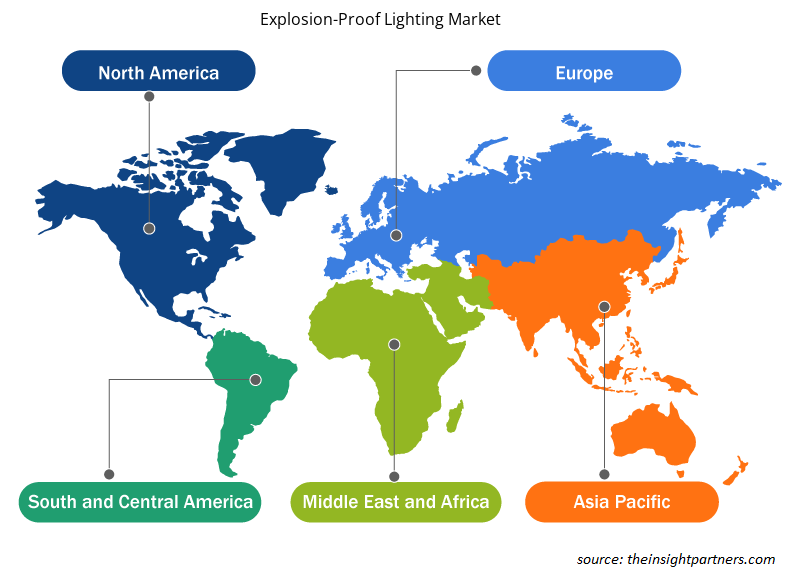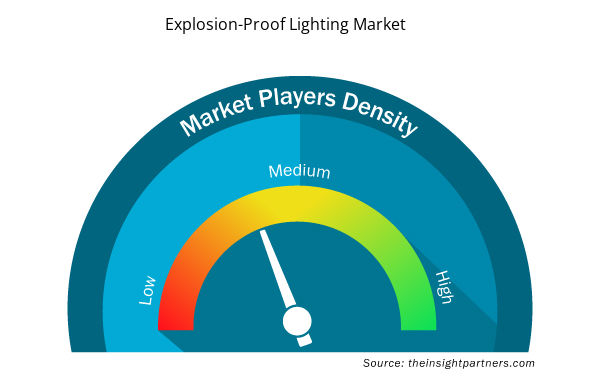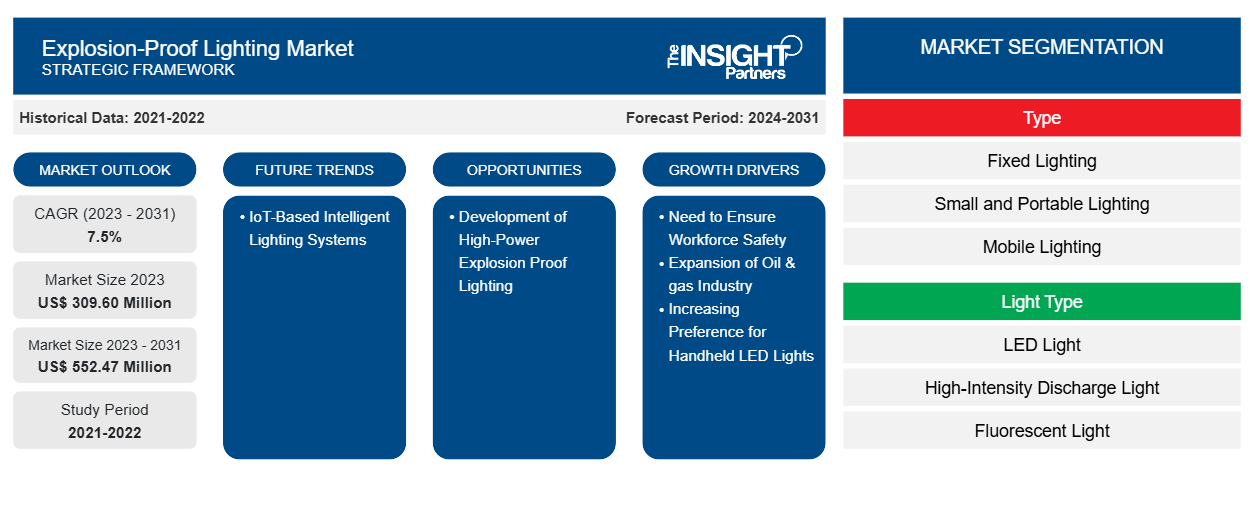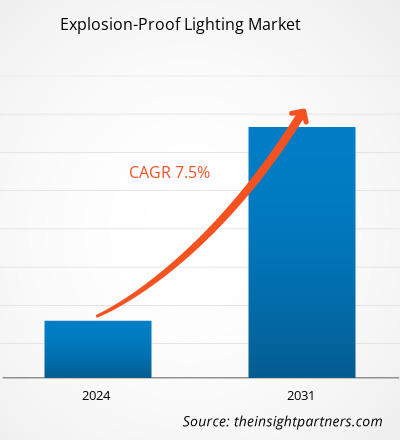防爆照明市场规模预计将从 2023 年的 3.096 亿美元增至 2031 年的 5.5247 亿美元。预计 2023-2031 年期间该市场的复合年增长率将达到7.5%。基于物联网的智能照明系统很可能在未来几年引领市场趋势。
防爆照明市场分析
工业和商业环境中危险场所的工作场所安全和适当维护促进了照明等防爆设备的发展和增长。目前,市场增长由石油和天然气、化工和能源等行业推动。这些行业危险场所的某些安全规范迫使这些行业安装更多经过认证的产品。
防爆照明市场概况
通过实施最佳实践,可以轻松应对不同行业的危险事件。 有多个机构负责对可用于危险区域的设备类型进行认证。 例如,在北美,美国保险商实验室 (UL) 和美国工厂互助保险 (FM) 通常提供标准、测试和认证,而在加拿大,加拿大标准协会 ( CSA ) 提供批准。 同样,在欧洲,潜在爆炸性环境设备 (即ATEX )和国际电工委员会 ( IEC ) 提供全球认可的标准。 这些组织不实施他们的测试,例如 UL、FM 和CSA。 但是,他们会通知机构进行测试以满足他们设定的标准。 一些北美参与者还根据IEC / 或ATEX标准对其产品进行认证,以便在国际上销售它们。 但是,这些组织提供的认证彼此之间有很大不同。
定制此报告以满足您的需求
您可以免费定制任何报告,包括本报告的部分内容、国家级分析、Excel 数据包,以及为初创企业和大学提供优惠和折扣
- 获取此报告的关键市场趋势。这个免费样品将包括数据分析,从市场趋势到估计和预测。
防爆照明市场驱动因素和机遇
石油和天然气行业的扩张
石油和天然气行业在各国经济转型中发挥着重要作用。该行业占全球能源资源消耗的最大份额。天然气很可能成为未来几年增长最快的化石燃料之一。许多国家都在扩大石油生产能力以满足国内能源需求。根据国际能源署 (IEA )的数据,全球石油需求预计将在 2022-2028 年间增长 6%,化工、能源、电力、航空和石化行业的需求巨大。预计到 2028 年,全球需求最终将达到每天 1.057 亿桶。各行业对石油的需求迅速增长,促使石油和天然气行业参与者通过工厂扩建战略扩大产能,这就需要防爆设备(如照明设备),以便通过提高工人的安全性来有效监控和控制工厂运营。
根据2023 年 11 月发布的Urwald eV报告,全球 384 家企业报告称,2021-2023 年期间,石油和天然气勘探活动的平均资本支出超过 1000 万美元。投资石油和天然气勘探的前七大公司分别是中国石油天然气集团公司(59 亿美元)、中国海洋石油总公司(32 亿美元)、沙特阿美公司(28 亿美元)、Pemex(26 亿美元)、中石化集团(24 亿美元)、先锋自然资源公司(21 亿美元)和壳牌公司(20 亿美元)。这些投资使他们能够采用技术先进、智能和智能的防爆照明系统,以提高工人的能见度并保护他们免受意外事件的影响。因此,全球不断扩张的石油和天然气行业推动了防爆照明市场的增长。
大功率防爆照明灯的研制
防爆照明主要用于存在可燃气体和粉尘的危险和苛刻环境中。这些灯具具有良好的防爆功能,适用于IIA、IIB和IIC爆炸性气体环境。除了主要应用于石油和天然气、化学品、制药、能源和采矿行业外,它们还可能应用于铁路、电力、冶金、石油和石化、化工、钢铁、航空和造船业等。这些行业对大功率防爆照明的需求很大,以防止工作场所的设备或其他事故引起的爆炸。大功率防爆照明产品旨在承受恶劣的工作条件,包括高温和极热,非常适合在危险场所使用。东莞市明阳照明有限公司提供精心设计的大功率防爆照明系统,可在高温条件下稳定耐用地运行。这些系统采用高强度铝散热器和空气对流结构,有助于承受热量。恒流驱动、短路和过压保护以及高电磁兼容性是该系统的其他值得注意的功能,使其适用于冶金、石油、石化、化学品、钢铁、石油和天然气、海洋和采矿等危险行业。因此,预计大功率防爆照明系统的发展将在预测期内为防爆照明市场的增长创造丰厚的机会。
防爆照明市场报告细分分析
有助于得出防爆照明市场分析的关键部分是类型、灯具类型和最终用户。
- 根据类型,市场分为固定照明、小型便携式照明和移动照明。固定照明部分在 2023 年占据了最大的市场份额。
- 根据照明类型,市场分为 LED 灯、高强度放电灯、荧光灯和白炽灯。LED 灯部分在 2023 年占据了最大的市场份额。
- 就最终用户而言,市场细分为石油和天然气、化工、制药、能源、制造、食品和饮料、军事和国防、运输和物流、清洁和医疗、涂装车间和应用技术、农业和农业、公共和社区等。石油和天然气部门在 2023 年占据了市场主导地位。
防爆照明市场份额按地区分析
防爆照明市场报告的地理范围主要分为五个区域:北美、亚太、欧洲、中东和非洲、南美和中美。
2023 年,亚太地区占据了相当大的市场份额。亚太防爆照明市场分为中国、印度、日本、澳大利亚、韩国和亚太地区其他地区。预计该地区将在 2023-2031 年期间创下市场最高复合年增长率,预计的市场增长可归因于采矿业的扩张和政府对智能制造设施发展的支持。根据国际能源署 (IEA) 2023 年的一份报告,印度、中国和印度尼西亚为全球煤炭生产贡献了巨大份额。2023 年,中国煤炭产量增长 3.3%,达到 4,631 公吨,比 2022 年的产量高出 417 公吨。同样,印度的煤炭产量增长了 7%,在 2023 年达到 989 公吨。这些国家的政府专注于鼓励采矿业的技术进步并支持智能制造设施的发展,这表明这些行业对防爆照明的潜在需求。根据 NS Energy 发表的一篇文章,印度政府计划在 2021-2025 年期间启动 647 个石油和天然气项目,以将印度转变为以天然气为基础的经济体。此外,根据国家石油公司中石化的数据,2022 年中国天然气需求量达到 3950 亿立方米,较 2021 年的 3700 亿立方米增长 7%。石油和天然气行业的工人通常在危险场所和爆炸性环境中工作。因此,石油和天然气项目数量的激增推动了亚太地区对防爆照明的需求,以保护员工免受危险气体蒸气、易燃液体或可燃粉尘的伤害。
防爆照明市场区域洞察
Insight Partners 的分析师已详尽解释了预测期内影响防爆照明市场的区域趋势和因素。本节还讨论了北美、欧洲、亚太地区、中东和非洲以及南美和中美洲的防爆照明市场细分和地理位置。

- 获取防爆照明市场的区域具体数据
防爆照明市场报告范围
| 报告属性 | 细节 |
|---|---|
| 2023 年的市场规模 | 3.096亿美元 |
| 2031 年市场规模 | 5.5247亿美元 |
| 全球复合年增长率(2023 - 2031) | 7.5% |
| 史料 | 2021-2022 |
| 预测期 | 2024-2031 |
| 涵盖的领域 | 按类型
|
| 覆盖地区和国家 | 北美
|
| 市场领导者和主要公司简介 |
|
市场参与者密度:了解其对商业动态的影响
防爆照明市场正在快速增长,这得益于终端用户需求的不断增长,而这些需求又源于消费者偏好的不断变化、技术进步以及对产品优势的认识不断提高等因素。随着需求的增加,企业正在扩大其产品范围,进行创新以满足消费者的需求,并利用新兴趋势,从而进一步推动市场增长。
市场参与者密度是指在特定市场或行业内运营的企业或公司的分布情况。它表明在给定市场空间中,相对于其规模或总市场价值,有多少竞争对手(市场参与者)存在。
防爆照明市场的主要公司有:
- ABB有限公司
- 哈勃公司
- 伊顿公司
- 科特姆公司
- 倍加福
- 艾默生电气公司
免责声明:上面列出的公司没有按照任何特定顺序排列。

- 了解防爆照明市场主要参与者概况
防爆照明市场新闻及最新发展
防爆照明市场通过收集一手和二手研究后的定性和定量数据进行评估,其中包括重要的公司出版物、协会数据和数据库。防爆照明市场的一些发展如下所列:
- Airfal 扩大了其 ATEX 产品组合,推出了 GLASSEX,这是一款由玻璃制成的 IP69K 和 IK07 防护等级的灯具,这种材料与许多化学品具有很高的兼容性,因此对腐蚀性环境具有很强的抵抗力。(来源:Airfal,新闻稿,2021 年 4 月)
- 艾默生最初为陆基钻井平台设计了 Appleton Rigmaster LED 线性灯具系列,将其低调、轻便和节能的设计带入了新的照明应用。Appleton Rigmaster 现已可用于防爆、危险和普通工业场所,使灯具适合地下隧道、铸造厂、仓库和食品加工厂,以及其他存在污垢、灰尘和潮湿问题的地方。(来源:艾默生电气公司,新闻稿,2023 年 1 月)
防爆照明市场报告范围和交付成果
“防爆照明市场规模和预测(2021-2031)”报告对以下领域进行了详细的市场分析:
- 防爆照明市场规模及全球、区域和国家层面所有主要细分市场的预测
- 防爆照明市场趋势,以及驱动因素、限制因素和关键机遇等市场动态
- 详细的 PEST 和 SWOT 分析
- 防爆照明市场分析涵盖主要市场趋势、全球和区域框架、主要参与者、法规和最新市场发展
- 行业格局和竞争分析,涵盖市场集中度、热点图分析、知名参与者以及防爆照明市场的最新发展
- 详细的公司简介
- 历史分析(2 年)、基准年、预测(7 年)及复合年增长率
- PEST 和 SWOT 分析
- 市场规模价值/数量 - 全球、区域、国家
- 行业和竞争格局
- Excel 数据集



Report Coverage
Revenue forecast, Company Analysis, Industry landscape, Growth factors, and Trends

Segment Covered
This text is related
to segments covered.

Regional Scope
North America, Europe, Asia Pacific, Middle East & Africa, South & Central America

Country Scope
This text is related
to country scope.
常见问题
The global explosion proof lighting market is estimated to register a CAGR of 7.5% during the forecast period 2023–2031.
The global explosion proof lighting market is expected to reach US$ 552.47 million by 2031.
IoT-based intelligent lighting systems to play a significant role in the global explosion proof lighting market in the coming years.
The key players holding majority shares in the global explosion proof lighting market are ABB Ltd, Eaton Corp Plc, Cortem S.p.A., Pepperl+Fuchs SE, ABTECH, Signify Holding (Philips), Glamox, TREVOS, a.s., TEP Ex d.o.o., Hubbell Inc, Emerson Electric Co, Rockwell Automation Inc, Adolf Schuch GmbH, Airfal International, LDPI, Inc, R. STAHL AG, NORKA, Alfred PRACHT Lichttechnik GmbH.
North America dominated the explosion proof lighting market in 2023.
Need to ensure workforce safety, expansion of oil & gas industry, and increasing preference for handheld LED lights are the major factors that propel the global explosion proof lighting market.
Trends and growth analysis reports related to Electronics and Semiconductor : READ MORE..
The List of Companies - Explosion Proof Lighting Market
- ABB Ltd
- Hubbell Inc
- Eaton Corp Plc
- Cortem S.p.A.
- Pepperl+Fuchs SE
- Emerson Electric Co
- Rockwell Automation Inc
- General Electric Co
- Adolf Schuch GmbH
- Airfal International
- LDPI, Inc
- ABTECH
- Signify Holding (Philips)
- R. STAHL AG
- NORKA
- Glamox
- TREVOS, a.s.
- TEP Ex d.o.o.
- Alfred PRACHT Lichttechnik GmbH
The Insight Partners performs research in 4 major stages: Data Collection & Secondary Research, Primary Research, Data Analysis and Data Triangulation & Final Review.
- Data Collection and Secondary Research:
As a market research and consulting firm operating from a decade, we have published and advised several client across the globe. First step for any study will start with an assessment of currently available data and insights from existing reports. Further, historical and current market information is collected from Investor Presentations, Annual Reports, SEC Filings, etc., and other information related to company’s performance and market positioning are gathered from Paid Databases (Factiva, Hoovers, and Reuters) and various other publications available in public domain.
Several associations trade associates, technical forums, institutes, societies and organization are accessed to gain technical as well as market related insights through their publications such as research papers, blogs and press releases related to the studies are referred to get cues about the market. Further, white papers, journals, magazines, and other news articles published in last 3 years are scrutinized and analyzed to understand the current market trends.
- Primary Research:
The primarily interview analysis comprise of data obtained from industry participants interview and answers to survey questions gathered by in-house primary team.
For primary research, interviews are conducted with industry experts/CEOs/Marketing Managers/VPs/Subject Matter Experts from both demand and supply side to get a 360-degree view of the market. The primary team conducts several interviews based on the complexity of the markets to understand the various market trends and dynamics which makes research more credible and precise.
A typical research interview fulfils the following functions:
- Provides first-hand information on the market size, market trends, growth trends, competitive landscape, and outlook
- Validates and strengthens in-house secondary research findings
- Develops the analysis team’s expertise and market understanding
Primary research involves email interactions and telephone interviews for each market, category, segment, and sub-segment across geographies. The participants who typically take part in such a process include, but are not limited to:
- Industry participants: VPs, business development managers, market intelligence managers and national sales managers
- Outside experts: Valuation experts, research analysts and key opinion leaders specializing in the electronics and semiconductor industry.
Below is the breakup of our primary respondents by company, designation, and region:

Once we receive the confirmation from primary research sources or primary respondents, we finalize the base year market estimation and forecast the data as per the macroeconomic and microeconomic factors assessed during data collection.
- Data Analysis:
Once data is validated through both secondary as well as primary respondents, we finalize the market estimations by hypothesis formulation and factor analysis at regional and country level.
- Macro-Economic Factor Analysis:
We analyse macroeconomic indicators such the gross domestic product (GDP), increase in the demand for goods and services across industries, technological advancement, regional economic growth, governmental policies, the influence of COVID-19, PEST analysis, and other aspects. This analysis aids in setting benchmarks for various nations/regions and approximating market splits. Additionally, the general trend of the aforementioned components aid in determining the market's development possibilities.
- Country Level Data:
Various factors that are especially aligned to the country are taken into account to determine the market size for a certain area and country, including the presence of vendors, such as headquarters and offices, the country's GDP, demand patterns, and industry growth. To comprehend the market dynamics for the nation, a number of growth variables, inhibitors, application areas, and current market trends are researched. The aforementioned elements aid in determining the country's overall market's growth potential.
- Company Profile:
The “Table of Contents” is formulated by listing and analyzing more than 25 - 30 companies operating in the market ecosystem across geographies. However, we profile only 10 companies as a standard practice in our syndicate reports. These 10 companies comprise leading, emerging, and regional players. Nonetheless, our analysis is not restricted to the 10 listed companies, we also analyze other companies present in the market to develop a holistic view and understand the prevailing trends. The “Company Profiles” section in the report covers key facts, business description, products & services, financial information, SWOT analysis, and key developments. The financial information presented is extracted from the annual reports and official documents of the publicly listed companies. Upon collecting the information for the sections of respective companies, we verify them via various primary sources and then compile the data in respective company profiles. The company level information helps us in deriving the base number as well as in forecasting the market size.
- Developing Base Number:
Aggregation of sales statistics (2020-2022) and macro-economic factor, and other secondary and primary research insights are utilized to arrive at base number and related market shares for 2022. The data gaps are identified in this step and relevant market data is analyzed, collected from paid primary interviews or databases. On finalizing the base year market size, forecasts are developed on the basis of macro-economic, industry and market growth factors and company level analysis.
- Data Triangulation and Final Review:
The market findings and base year market size calculations are validated from supply as well as demand side. Demand side validations are based on macro-economic factor analysis and benchmarks for respective regions and countries. In case of supply side validations, revenues of major companies are estimated (in case not available) based on industry benchmark, approximate number of employees, product portfolio, and primary interviews revenues are gathered. Further revenue from target product/service segment is assessed to avoid overshooting of market statistics. In case of heavy deviations between supply and demand side values, all thes steps are repeated to achieve synchronization.
We follow an iterative model, wherein we share our research findings with Subject Matter Experts (SME’s) and Key Opinion Leaders (KOLs) until consensus view of the market is not formulated – this model negates any drastic deviation in the opinions of experts. Only validated and universally acceptable research findings are quoted in our reports.
We have important check points that we use to validate our research findings – which we call – data triangulation, where we validate the information, we generate from secondary sources with primary interviews and then we re-validate with our internal data bases and Subject matter experts. This comprehensive model enables us to deliver high quality, reliable data in shortest possible time.


 获取此报告的免费样本
获取此报告的免费样本